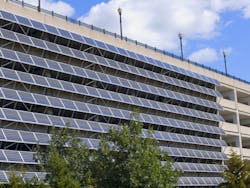To most of the world the electric vehicle (EV) revolution simply means using a plug rather than a fuel pump to keep a car running. But in truth it will require a significant overhaul of energy systems and infrastructure, one that’s likely to get businesses and even households considering microgrids.
By Smile Fight/Shutterstock.com
Andy Haun, senior vice president and chief technology officer, microgrids, at Schneider Electric, offered us a view of what’s to come in a recent conversation with Microgrid Knowledge.
As Haun described it, preparing for EVs is more than a matter of installing charging networks. From the power plant to the service station, electricity demand will change, requiring a rethinking of distribution systems, particularly as society embraces more power-hungry fast chargers. Getting these systems in place can significantly delay EV use and add to costs.
Start with the home. Think you can just buy an EV and charger and you’re set to drive your new car? Not necessarily. Your home may lack the adequate electric capacity for the charger. Often transformers and breakers already function close to the home’s limit.
“When you want to add in an electric vehicle charging infrastructure to that site, you may actually exceed the capacity of the service entrance. And that means you have to do something to bring more power to the infrastructure to be able to support charging,” Haun said.
Time and money
Then there is the issue of the amount of power the charger requires. More and more, EV owners want fast chargers, but they use a lot more electricity than their slower counterparts. How much? About double the amount of energy of a home’s air conditioning system and oven, he said.
As a result, the homeowner may need to increase the amp load center, and the local utility may need to upgrade the pole mounted transformer. It can be a shock to homeowners to learn that a utility schedules transformer changes months out, meaning they won’t be driving their new electric vehicle anytime soon. Suddenly on-site energy — a home microgrid, nanogrid, or solar plus storage — starts to sound more appealing, since it avoids the transformer change.
But time is only part of the equation. Money plays into it too. The utility will charge for the upgrade. Of course a microgrid costs money too, and homeowners will need to analyze payback of each option, given their situation. In doing so, it’s important to factor in some advantages a microgrid offers.
Haun noted that once you install the on-site energy, you own it, and can use it to avoid buying energy from the grid. The on-site energy — depending on its size — also may provide electricity for other parts of your home, which is particularly valuable when there is a power outage on the grid. And last, installing a microgrid offers an opportunity to green one’s power supply. Sixty-one percent of grid power comes from fossil fuels.
Issues for commercial EV fleets
All of these issues magnify when businesses and delivery companies electrify their fleets. Delays for utility work, for example, may be longer — a year or more, he said.
This is because the scope of the work is larger. “The utility has got to come in and not just put in a different transformer on a pole, but actually pull out a substation transformer,” Haun said.
These issues can deter EV sales. So manufacturers have begun to address the problem by incorporating microgrids as part of a charging package.
“When they make the sale of their vehicle, they want to make sure that the vehicle is suitably able to be charged by their fleet customers. They’re saying, ‘Look, I’m going to give you a greener, cheaper, easier way to operate the vehicle. And I’m also interested in helping you get infrastructure in place so that you can then charge those vehicles and run those vehicles,’” Haun said. “All the electric vehicle manufacturers are kind of taking the same approach to this.”
Microgrids are particularly important to businesses and public transit authorities that are electrifying fleets because their electrical systems tend to be woefully inadequate to the task of charging. Haun points to parking garages and park-and-rides as prime examples.
“Garages are designed today to have what? Some lighting and some security. And maybe, if there’s multiple levels, an elevator system,” he said.
At the same time, parking garages and covered lots often do have roof or exterior space that lends itself to a solar microgrid.
Solar panels mounted on exterior wall of parking garage in Saint Paul, Minn. Photo by Joe Ferrer/Shutterstock.com
Made for microgrids: remote locations, communities
Location also plays a big role in determining the need to upgrade electrical systems. Charging stations situated on remote highways may be near the end of a utility line where power was never needed before. Bringing service to the charging station requires either installation of a microgrid or new utility wires, poles and infrastructure.
A similar situation may occur in suburban neighborhoods. Even if each individual home is upgraded to accommodate fast chargers, the utility infrastructure serving the neighborhood, as a whole, may be inadequate.
A community or utility microgrid can take care of the problem, Haun said.
Andy Haun, senior vice president and chief technology officer, microgrids, Schneider Electric
This points to another interesting part of the electric vehicle/microgrid discussion. EVs aren’t just opening up a market for private microgrid developers. Utilities, too, are beginning to see opportunities. EVs increase demand for their product; utility-built microgrids offer a route to serve the demand.
Why would a utility build a microgrid rather than a new substation? Utilities must seek regulatory approval to build new infrastructure, but state commissions are increasingly skeptical about utilities adding centralized power to the system, Haun said. “They want to see more and more distributed energy put in place, more green energy.”
On top of that, utilities are beginning to partner with their customers to build microgrids, with the customer paying part of the cost. That makes the project even more appealing to cost conscious regulators.
Whether offered by a utility, private developer or EV company, microgrids are likely to play a growing role in the electric vehicle revolution. Their importance grows as it becomes increasingly clear that electrification of transportation requires a rethinking of our power system from home to business to the utility grid.
Subscribe to the free Microgrid Knowledge newsletter to track distributed energy trends.







